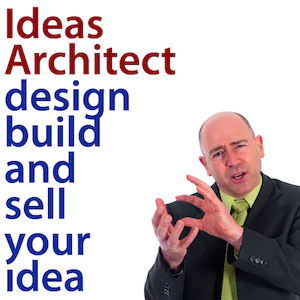Do More with Less
Do More with Less is episode #111 of the Ideas Architect Podcast. Here is the video and transcript…
Are you stretched to your limits? Are you just hanging on?
- Life is fast – keeping up with all the software updates is tough let alone mastering them
- Everything is complex – even buying eggs is hard because there are so many choices
- We’re busy – people expect more of us and there are constant grabs for our attention
- We can’t get enough – when was the last time you had enough sleep and woke up feeling refreshed?
Today I will show you five ways to get more done in less time with less effort and fewer resources.
The First Key to Get More Done
The first key to getting things done is to create a project. Projects define our focus and put a boundary around what’s important and what’s not.
It’s likely you’re already pretty good at planning and finishing your projects. You wouldn’t be in your current position if you weren’t.
But, the way we usually go about our projects is a lost opportunity.
Most project planning only focuses on the tasks we need to get done. While this is crucial, it’s not enough. If this is all we do we miss a big opportunity.
The first step to get more done: create a project
The Right Different
To get more done in less time with less effort and fewer resources you need to do things differently. Doing things better will only get you so far. Doing things differently requires a different perspective – the right different will take you much further.
I want you:
- To think differently about your projects,
- To be motivated and inspired about your work as you haven’t been before.
- And ultimately, I want you to be able to do more in less time, with less effort and fewer resources.
 Mission Impossible?
Mission Impossible?
You might be thinking that sounds like Mission Impossible. It would be if you only had one strategy for improving.
However, if you had 12 strategies and you added one strategy at a time until you had a number of them all working together then anything is possible.
If you simply improved 10% using four different strategies that would be a total improvement of 46%. Now that would be worth playing for!
Traditional Project Planning
Like Thomas Edison, I’ve failed a lot. I often failed to finish my projects.
I was an architect in my first career. Architects plan everything and then they hand the plan over to the builder who makes it all happen.
When I started my own business this didn’t work for me. I had lots of ideas but I couldn’t make them happen. This was frustrating and it was costing me time, money and my reputation.
Traditional project planning simply didn’t work for me. I had to come up with a different way to get things done.
The Rider and the Elephant
My research into neuroscience, psychology, entrepreneurs, linguistics and other areas showed the number one reason that our projects fail is a lack of motivation.
It’s like a rider on an elephant. We need the Rational Rider to provide direction and we need the Emotional Elephant to provide the energy to get things done. Our projects fail when the Rational Rider can’t keep the Emotional Elephant on track for long enough.
This is why planning what to do is not enough. We need both the rider and the elephant to work together.
The #1 reason our projects fail: lack of motivation
Why Traditional Planning Fails
The solution to project success is to design for motivation. Bernice McCarthy created the 4-Mat Motivation Model for teachers to provide lessons that appealed to everyone in the class.
Traditional Project Planning only appeals to one style of motivation – what needs to be done. This works for task-focused people and not for others like me.
When we appeal to all four different styles of motivation we multiply our ability to stay on track and complete our projects. This is the key to project success.
12 Ways to Get More Done
In each of the four areas of getting more done, in less time with less effort and with fewer resources there are three major strategies.
This gives us 12 growth strategies that we can apply to any project. Applying one strategy will give us a good boost, applying several will give us a big boost and applying all of them…
As a sample, let’s look at four strategies – one from each of our growth domains.
1: Pursue Inner Goals
Usually, our manager gives our projects to us. Research shows that our motivation levels flag and our resilience falls when we don’t have a choice over our work.
To overcome this drop in motivation and resilience we need to own the project we are given.
One of the most powerful ways to do this is by creating a personal or inner goal around one of the four types of intrinsic motivation: purpose, relationships, autonomy or mastery.
This will help us get more done because we have our own reason for succeeding.
Own your project by pursuing inner goals to get more done.
2: Create Simple Rules
In projects, we usually plan a lot. We try to identify all the steps along the way. This takes up time and effort and ignores the reality that any plan is trying to predict the future and is likely to be wrong.
The alternative is to plan more loosely using simple rules of thumb. Goldilocks did this when she was testing out which porridge to eat and which bed to sleep on. With this approach, you define how to respond to situations so individuals are empowered to make decisions along the way.
This keeps progress moving, avoids delays and maintains the overall strategic intent. As a result, more gets done in less time.
Stop doing big plans, start using simple rules of thumb to get more done
3: Design Your Environment
A lot of people rely on their willpower to tough their way through getting things done. This is an important short-term strategy that we all rely on.
However the problem is willpower uses a lot of energy and eventually we run out of it.
The alternative is to design your environment so that it is more likely that you will do the things you know you need to do. This invisible force allows you to get more done with less effort.
4: Make Powerful Requests
Having the right resources can make all the difference in completing our projects quickly and easily.
However, we typically approach our projects with the resources we are given. This is limiting.
The way to access almost any resource is to make a powerful request. This is not a guarantee that people will say ‘yes’ to all of your requests and it does shift your mindset to being more resourceful.
It also helps take away the illusion of limited resources.
Beat the illusion of limited resources with powerful requests
The Missed Opportunity
Finally, if we could get more done in less time with less effort and fewer resources that would be a great result. And it still misses the big opportunity of project planning.
Surveys show that between 60-80% of employees are not engaged in their work.
The single best way to get more done in less time with less effort and fewer resources is to be engaged in your work – be passionate, be motivated and be inspired.
We can achieve this if we design our work through the lens of motivation.
When was the last time you wowed yourself at work?
More: subscribe to our YouTube channel here
Listen, Download, Share
Podcast: Play in new window | Download | Embed
Subscribe: RSS

 Mission Impossible?
Mission Impossible?

